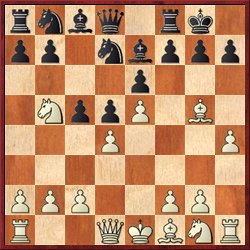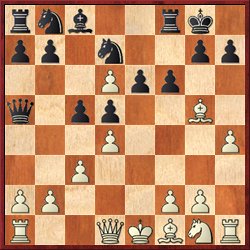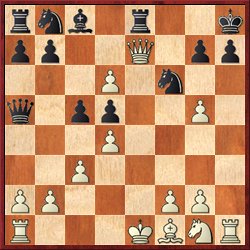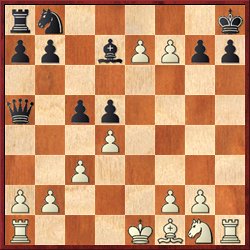This afternoon Mike Splane hosted his second chess salon. (Well, he called it a party but I like the word “salon,” which calls to mind an image of erudite people gathered in a nineteenth-century drawing room, puffing pipes as they discuss Serious Issues.) I missed the first one, but he is planning to host them monthly, so I will have many more chances to attend, I hope.
This one was quite successful, with 10 players attending, all in the Class A/Expert/Master range, thus facilitating Serious Discussions. We started with some casual 5-minute chess, then proceeded to demonstrate a few recent games, and finally we played some 10-minute team chess.
First up was Jim Bennett, who tied for first in the Class A section of the CalChess State Championship last weekend, with a 5-1 score. It was his greatest chess success ever, and he was justifiably excited. He even brought us two pizzas, paid for out of his prize money! He showed us his best game from the tournament, a very thematic Colle Attack that I will probably do a ChessLecture on, so I won’t say anything more about it here. After Jim, Richard Koepcke showed two of his games from the same tournament.
However, the most unique and wonderful game that I saw today was not a tournament game but a rapid team game that Mike played a week or so ago. His partner was, I believe, named George. (I hope he’ll confirm this and tell us the last name and maybe the opponents’ names as well).
It’s a miniature that is so sweet you would swear it must be a book trap. But it isn’t! According to Chess Base the position on move 9 has never occurred in tournament play, and so the neat final combination certainly hasn’t.The game began with the Albin-Chatard Variation of the French Defense:
1. e4 e6 2. d4 d5 3. Nc3 Nf6 4. Bg5 Be7 5. e5 Nfd7 6. h4 c5
The move 6. … a6 is more common, but this move seems to be playable. Black is waving a red flag at White, inviting his knight to come to b5. White accepts the invitation in this game. Possibly 7. Bxe7 first is a better move order.
7. Nb5 O-O?!
I don’t know any theory here, but Mike said (and the computer agrees) that Black should play 7. … f6 right away.
White to move.
9. Nd6!? …
According to Gjon Feinstein, going after the exchange with 9. Bxe7 Qxe7 10. Nc7 is a good way for White to lose. (Correction posted 6/10/11: I misunderstood Gjon’s meaning here. His point was that Black will get a lot of counterplay for the exchange with … f6, … e5 etc. He did not mean to imply that White stands worse. It’s a sharp game with chances for both sides.) After the text move we are already in uncharted waters!
9. … Qa5+ 10. c3 Bxd6 11. ed f6
White to move.
So far, pretty sensible. White’s next move is the key move of the game, and Mike gave full credit to his partner for finding it.
12. Qg4! …Â
According to the computer this does not win by force, and in fact White does not even have an advantage. However, in a blitz game played by humans, this sort of move wins 90 percent of the time.
Black’s most natural defense is 12. … Nb6, and after 13. Bh6 Rf7 White’s lack of development makes it hard for him to turn up the pressure. However, the Black team found it impossible to resist taking the bishop — especially because it seems that White is losing his queen as well!
12. … fg 13. Qxe6+ Kh8
If 13. … Rf7, then 14. Bd3! (planning Bxh7+, or Bxg6 if Black plays 14. … g6) is extremely strong.
14. hg Nf6 15. Qe7 Re8
White to move.
Black wins the queen, as promised … but it’s White who wins the game.
16. gf! Rxe7 17. de Bd7 18. f7! and Black resigns.
The final position definitely deserves a diagram.
This is one of those positions that makes you do a double-take. How could such a position possibly arise in a game where both players played somewhat reasonable moves? White has lost his queen for a rook, and hasn’t developed any of his pieces, but he’s winning, thanks to his ridiculously powerful e- and f-pawns.
Earlier in the salon we had talked about how side-by-side pawn duos are a good thing because they are more flexible than pawn pairs where one pawn is in front of the other. This position takes that concept to the extreme. White’s pawns are indeed very flexible. He can push the e-pawn and checkmate, or he can push the f-pawn and checkmate!







{ 2 comments… read them below or add one }
Great miniature!
Congratulations to Jim Bennett! I once played 6 or 7 moves against his Dragon in a Thursday night club tournament game before I had to abandon the game and run home because my wife went into labor with our daughter. I had 2 prior (complete) games with him that I enjoyed very much. Jim is a gentleman and a fighter at the board. Looking forward to your lecture on his game.
I think my partner in this game was George Jeffers and we were playing against Joji Escoto and George Mandrusov.
After I played 14 hg our opponents both thought it was their partner’s turn to move. In the confusion our side gained about two minutes of time to examine the position and I worked it out to mate.
I share the previous poster’s high regard for Jim Bennett.
Mike Splane